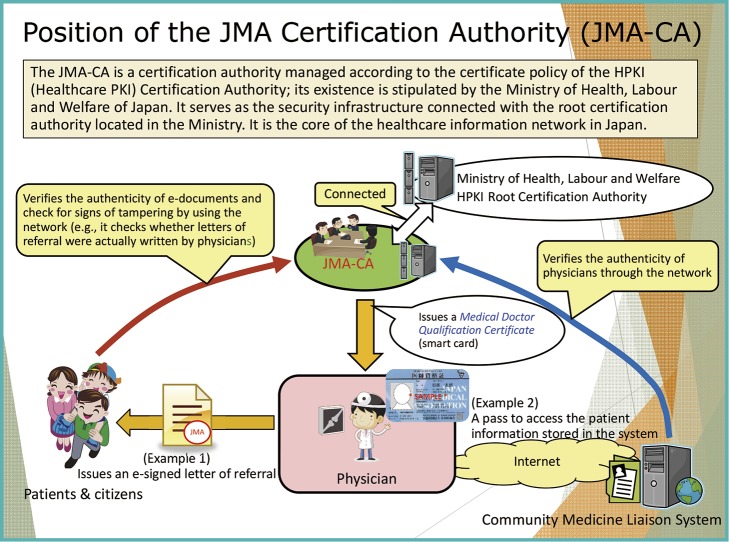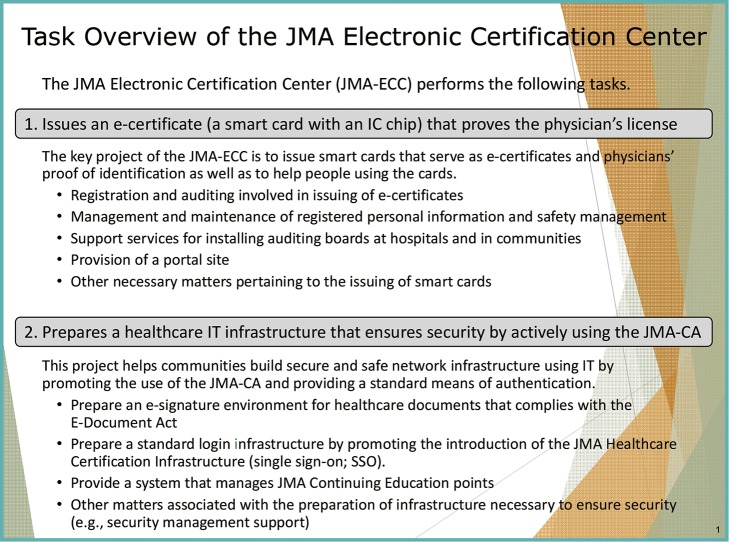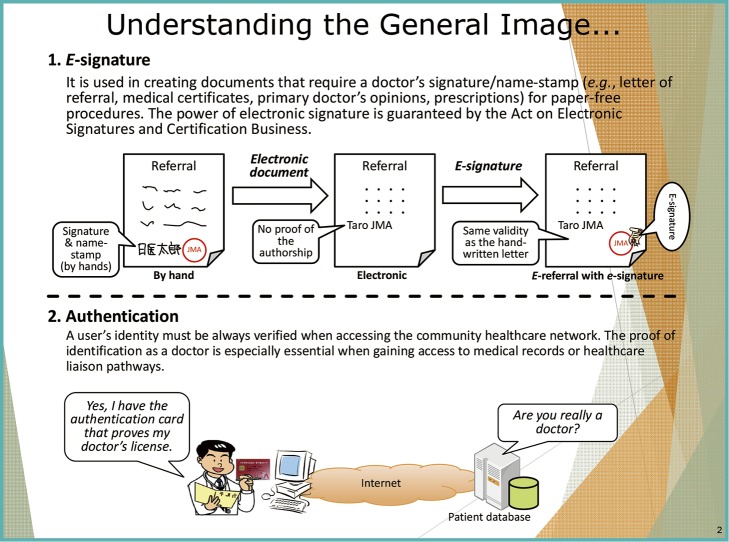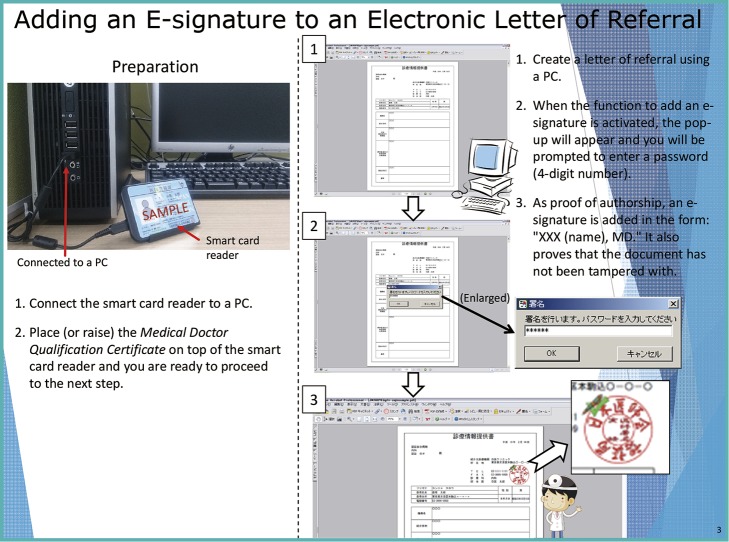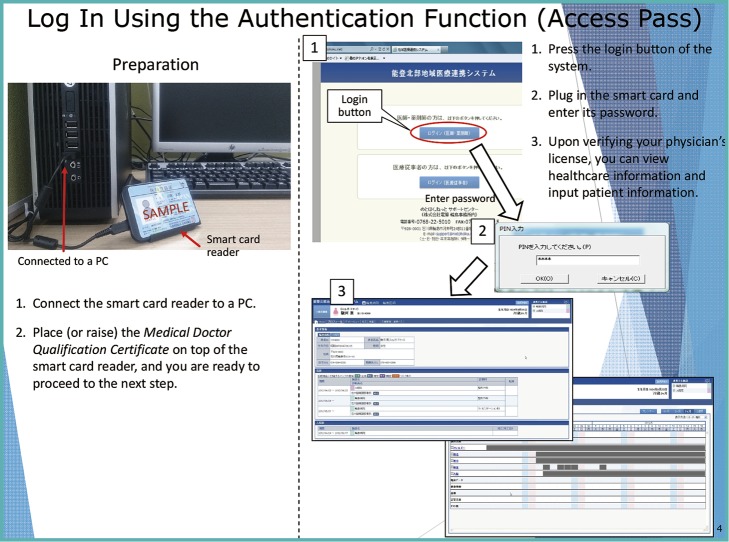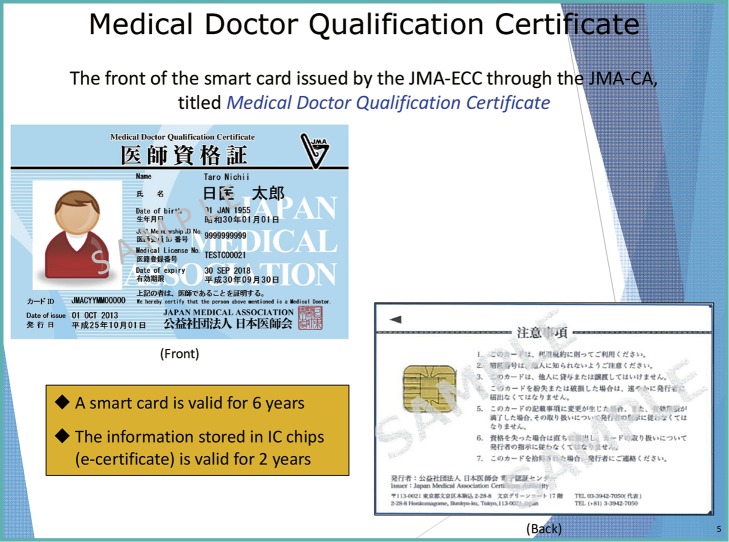The development in information technology (IT) is rapidly advancing in Japan, and its impact is felt in the healthcare and welfare sectors as well. Efforts have been undertaken to enhance care practices by taking advantage of IT through sharing and analyzing healthcare information.
However, the hasty introduction of IT has raised concerns with respect to security and privacy protection. Further, cases of identity fraud, where unscrupulous individuals pretend to be physicians, have become a social problem, raising concern regarding a basic credential system for medical practitioners.
In response to these circumstances, the Japan Medical Association (JMA) has been continuously making efforts in developing a safe and secure environment for healthcare and welfare by striving to understand the “bright and dark sides” of IT, given its mandate as an organization that represents physicians in Japan.
As part of our efforts, we offer the service of the JMA Certification Authority (JMA-CA). It is tasked with verifying the status of national medical license holders, which is the most basic foundation in this field. This service, which is interconnected with the Ministry of Health, Labour and Welfare’s system, enables electronic verification of the license status of physicians (Slide 1).
Slide 1.
In addition, the JMA Electronic Certification Center (JMA-ECC) was launched in May 2013 as an affiliated internal organization to manage the JMA-CA. The JMA-ECC issues smart cards called Medical Doctor Qualification Certificate upon strict review of the license status and eligibility of physicians. The JMA-ECC also offers support services for the preparation of a safe and secure IT infrastructure for healthcare information using the Medical Doctor Qualification Certificate cards (Slide 2).
Slide 2.
There are two ways to use the smart card: one is in adding an electronic signature to a document; and the other is in authenticating one’s identity when logging in the network system (log-in authentication).
As the name suggests, an electronic signature, or e-signature, enables the cardholder to sign an electronic document electronically. Adding an e-signature to a document in the healthcare network system helps prove the authorship of the signed document as well as the active license status of the author as a physician. If the content of an e-signed document has been altered, the electronic properties of the document will allow others to detect the changes. This function is crucial in medical practice because such alterations—changes in prescription information when a physician is notifying patient information to others, for example—could result in the difference between life and death for patients. An e-signature can prevent such an incident.
Another function, identity authentication, is used when sharing patient information through IT to verity the eligibility and qualification of the person accessing the system. If a non-eligible person can access patient information, the duty of confidentiality among physicians may be compromised. This function is offered as a secure means to verify the credibility of physicians’ license. The general image of the smart card is shown in Slide 3, and examples of its use are shown in Slides 4 and 5.
Slide 3.
Slide 4.
Slide 5.
An example of an e-signature is shown in Slide 4, which describes the steps involved when adding an e-signature to a letter of referral prepared using a PC. In Japan, the custom is to use a name stamp instead of a signature, and as such, the image here on the sample electronic letter of referral also uses the image of a stamp. The e-signature (e-stamp) serves as a guarantee that a physician wrote the letter, and that the document has not been tampered with after the e-signature was added.
In the example shown in Slide 5, the network system verifies the license status of the user (i.e., a physician) when he/she accesses healthcare information (patient information) through IT. As shown here, the Medical Doctor Qualification Certificate cards issued by the JMA-ECC are used as secure proof of identification as physicians within the IT realm.
The next slide (Slide 6) shows the front and back of a Medical Doctor Qualification Certificate card.
Slide 6.
The front bears the name of the card, Medical Doctor Qualification Certificate, and lists the cardholder’s information, such as the full name, date of birth, and physician registration number. Therefore, through this card, the cardholder can prove his/her license as a physician not only in the world of IT but also in daily life by physically presenting the card to others.
At present, the card is not accepted as an official proof of identification because it is regarded as simply a certificate issued by the JMA. However, we are negotiating with various other parties and working toward its acceptance as an official proof of identification for physicians.
Through these efforts, the JMA will continue to promote and propagate the Medical Doctor Qualification Certificate cards in both the IT world and daily practice by offering secure credentials for physicians. By providing this viable identification system, we hope to help build a safe and secure healthcare provision system in Japan that would protect patients and the Japanese people at large.
Footnotes
*1 This article is based on the lecture at the JMA Conference on Medical Information Technology held on February 8-9, 2014.



